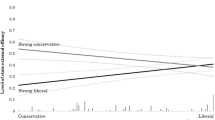Abstract
In the 1982 and 1984 American national election surveys the CPS deleted a subset of its longstanding measures of political efficacy. This paper employs covariance structure analysis to test a two-factor measurement model based on alternative indicators. The model has an excellent fit for data from the 1964–84 national surveys as well as for different educational, gender, and racial groups in the 1984 study. Consistent with previous theorizing, the internal efficacy factor is significantly more stable than the external factor. Also, the two efficacy factors correlate as expected with measures of general personal competence and political trust. The paper is the first to use LISREL structured means tests to test group differences in levels of efficacy or other important political attitudes. Since this technique is not well-known, a tutorial appendix describing its implementation in LISREL VI is included to facilitate future research.
Similar content being viewed by others
References
Abramson, P.R. (1983). Political Attitudes in America. San Francisco: W.H. Freeman and Company.
Acock, A.C., Clarke, H.D. & Stewart, M.C. (1985). ‘A new model for old measures: A covariance structure analysis of political efficacy’, Journal of Politics 47: 1061–84.
Almond, G. & Sidney, V. (1963). The Civic Culture. Princeton, N.J.: Princeton University Press.
Balch, G.S. (1974). “Multiple indicators in survey research: The concept ‘sense of political efficacy’”, Political Methodology 1: 1–43.
Barnes, S.H. & M.Kaase (1979). Political Action. Beverly Hills: Sage Publications.
Bennett, S.E. (1984). “The dimensions of Americans' basic political orientations, 1964–1980”, Paper presented at the Annual Meeting of the Midwest Political Science Association, Chicago, Ill.
Center for Political Studies (1980). American National Election Study, 1984. Second ICPSR edition, Vol. 1. Ann Arbor, Mich.: Inter-university Consortium for Political and Social Research.
Clarke, H.D. & Acock, A.C. (1989). “National elections and political attitudes: The case of political efficacy”, British Journal of Political Science 19: 551–62.
Craig, S.C. & Maggiotto, M.A. (1982). “Measuring political efficacy”, Political Methodology 8: 85–109.
Easton, D. (1965). A Systems Analysis of Political Life. New York: Wiley.
Ineygar, S. (1980). “Subjective political efficacy as a measure of diffuse support”, Public Opinion Quarterly 44: 249–56.
Hayduk, L. (1987). Structural Equation Modeling with LISREL. Baltimore: Johns Hopkins University Press.
Jennings, M.K. & Niemi, R.G. (1981). Generations and Politics. Princeton, N.J.: Princeton University Press.
Joreskog, K.G. & Sorbom, D. (1984), LISREL VI: User's Guide. 3rd Edition. Mooresville, Indiana: Scientific Software, Inc.
Lane, R.E. (1959). Political Life. New York: The Free Press.
Lomax, R.G. (1983). “A guide to multiple-sample structural equation modeling”, Behavior Research Methods and Instrumentation 15: 580–84.
Long, J.S. (1983). Confirmatory Factor Analysis: A Preface to LISREL. Beverly Hills: Sage Publications.
McPherson, Miller, J., Welch, S., & Clark, C. (1977). “The stability and reliability of political efficacy: Using path analysis to test alternative models”, American Political Science Review 71: 509–21.
Milbrath, L. & Goel, M.L. (1977). Political Participation. 2nd edition. Chicago: Rand McNally.
Miller, W.E., Miller, A.H. & Schneider, E.J. (1980). American National Election Studies Data Sourcebook, 1952–1978. Cambridge: Harvard University Press.
Shingles, R.D. (1981). “Black political consciousness and political participation: The missing link”, American Political Science Review 75: 76–91.
Welch, S. & Clark, C. (1975). “Determinants of change in political efficacy: A test of two hypotheses, Journal of Political and Military Sociology 3: 207–17.
Author information
Authors and Affiliations
Rights and permissions
About this article
Cite this article
Acock, A.C., Clarke, H.D. Alternative measures of political efficacy: models and means. Qual Quant 24, 87–105 (1990). https://doi.org/10.1007/BF00221386
Issue Date:
DOI: https://doi.org/10.1007/BF00221386



